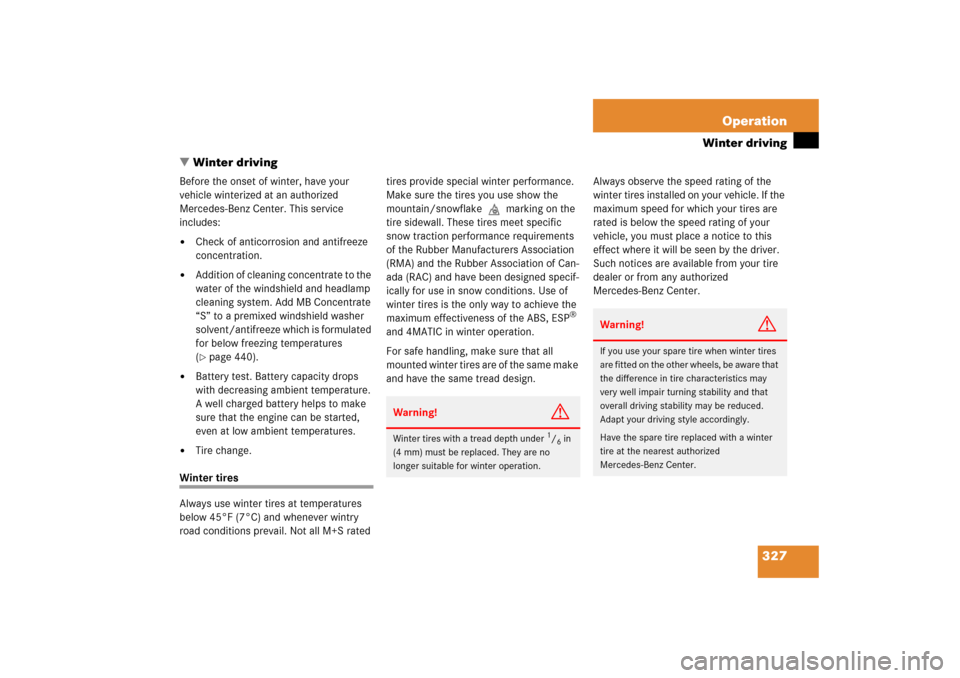Page 312 of 481

311 Operation
Tires and wheels
Reactivating the tire inflation pressure
monitor
The tire inflation pressure monitor must be
reactivated in the following situations:�
If you have changed the tire inflation
pressure.
�
If you have replaced the wheels or
tires.
�
If you have installed new wheels or
tires.
�
Using the tire placard on the driver’s
door B-pillar or, if available, the inside
of the fuel filler flap, make sure the tire
inflation pressure of all four tires is cor-
rect.
�
Press buttonè orÿ on the mul-
tifunction steering wheel repeatedly
until the standard display menu
appears in the multifunction display
(�page 143).
�
Press button j or k repeatedly
until you see the current tire inflation
pressures for each tire appear in the
multifunction display or the following
message appears in the multifunction
display:TIRE PRES. DISPLAY
APPEARS AFTER
DRIVING A FEW
MINUTES
�
Press the reset buttonJon the in-
strument cluster (
�page 140).The following message will appear in
the multifunction display:
MONITOR CURRENT
TIRE
PRESSURES?
�
Press the æ button.
The following message will appear in
the multifunction display:TIRE PRES. MONITOR
REACTIVATED The tire inflation pressure monitor will
now monitor the tire inflation pressure
values of all four tires.
The following message will appear in
the multifunction display:TIRE PRES. DISPLAY
APPEARS AFTER
DRIVING A FEW
MINUTES
iIf you are transporting a deflated tire in
the vehicle, do not activate the tire
inflation pressure monitor until�
the deflated tire is no longer in the
vehicle
�
you have inflated the tire to the
correct tire inflation pressure.
��
Page 327 of 481

326 OperationTires and wheelsRotating tires
Tire rotation can be performed on vehicles
with tires of the same dimension all
around. If your vehicle is equipped with
tires of the same dimension all around,
tires can be rotated, observing a
front-to-rear rotation pattern that will
maintain the intended rotation (spinning)
direction of the tire (
�page 300).
In some cases, such as when your vehicle
is equipped with mixed-size tires (different
tire dimension front vs. rear), tire rotation
is not possible.If applicable to your vehicle’s tire configu-
ration, tires can be rotated according to
the tire manufacturer’s recommended in-
tervals in the tire manufacturer’s warranty
pamphlet located in your vehicle literature
portfolio. If none is available, tires should
be rotated every 3 000 to 6 000 miles
(5 000 to 10 000 km), or sooner if neces-
sary, according to the degree of tire wear.
The same rotation (spinning) direction
must be maintained (
�page 300).
Rotate tires before the characteristic tire
wear pattern becomes visible (shoulder
wear on front tires and tread center wear
on rear tires).
Thoroughly clean the mounting face of
wheels and brake disks, i.e. the inner side
of the wheels/tires, during each rotation.
Check for and ensure proper tire inflation
pressure.For information on wheel change, see the
“Practical hints” section (
�page 403).
Warning!
G
Rotate front and rear wheels only if the tires
are of the same dimension.
If your vehicle is equipped with mixed-size
tires (different tire dimensions front vs.
rear), tire rotation is not possible.
Warning!
G
Have the tightening torque checked after
changing a wheel. Wheels could become
loose if not tightened with a torque of
110 lb-ft (150 Nm).
Only use genuine Mercedes-Benz wheel
bolts specified for your vehicle’s rims.
Page 328 of 481

327 Operation
Winter driving
�Winter driving
Before the onset of winter, have your
vehicle winterized at an authorized
Mercedes-Benz Center. This service
includes:�
Check of anticorrosion and antifreeze
concentration.
�
Addition of cleaning concentrate to the
water of the windshield and headlamp
cleaning system. Add MB Concentrate
“S” to a premixed windshield washer
solvent/antifreeze which is formulated
for below freezing temperatures
(�page 440).
�
Battery test. Battery capacity drops
with decreasing ambient temperature.
A well charged battery helps to make
sure that the engine can be started,
even at low ambient temperatures.
�
Tire change.
Winter tires
Always use winter tires at temperatures
below 45°F (7°C) and whenever wintry
road conditions prevail. Not all M+S rated tires provide special winter performance.
Make sure the tires you use show the
mountain/snowflake.marking on the
tire sidewall. These tires meet specific
snow traction performance requirements
of the Rubber Manufacturers Association
(RMA) and the Rubber Association of Can-
ada (RAC) and have been designed specif-
ically for use in snow conditions. Use of
winter tires is the only way to achieve the
maximum effectiveness of the ABS, ESP
®
and 4MATIC in winter operation.
For safe handling, make sure that all
mounted winter tires are of the same make
and have the same tread design.Always observe the speed rating of the
winter tires installed on your vehicle. If the
maximum speed for which your tires are
rated is below the speed rating of your
vehicle, you must place a notice to this
effect where it will be seen by the driver.
Such notices are available from your tire
dealer or from any authorized
Mercedes-Benz Center.
Warning!
G
Winter tires with a tread depth under
1/6in
(4 mm) must be replaced. They are no
longer suitable for winter operation.
Warning!
G
If you use your spare tire when winter tires
are fitted on the other wheels, be aware that
the difference in tire characteristics may
very well impair turning stability and that
overall driving stability may be reduced.
Adapt your driving style accordingly.
Have the spare tire replaced with a winter
tire at the nearest authorized
Mercedes-Benz Center.
Page 379 of 481
378 Practical hintsWhat to do if …?Display
Possible cause
Possible solution
H
TIRE PRESSURE
PLEASE CORRECT
The pressure is too low in one or more
tires.
�
Check and correct tire inflation pressure
as required (
�page 308).
TIRE PRESSURE
CAUTION, TIRE PRES.
One or more tires are deflating.
�
Carefully bring the vehicle to a halt, avoid-
ing abrupt steering and braking maneu-
vers. Observe the traffic situation around
you.
�
Change the damaged wheel
(�page 403).
�
Have the damaged wheel repaired or re-
placed at an authorized Mercedes-Benz
Center.
Warning!
G
Do not drive with a flat tire. A flat tire affects
the ability to steer or brake the vehicle.
You may lose control of the vehicle. Contin-
ued driving with a flat tire will cause exces-
sive heat build-up and possibly a fire.
Page 380 of 481
379 Practical hints
What to do if …?
Display
Possible cause
Possible solution
H
TIRE PRESSURE
CHECK TIRES
The pressure has fallen significantly in
one or more tires.
�
Carefully bring the vehicle to a halt, avoid-
ing abrupt steering and braking maneu-
vers. Observe the traffic situation around
you.
�
Check the tires. If no damage visible,
check and correct tire inflation pressure
as required.
�
Change the damaged wheel
(�page 403).
�
Have the damaged wheel repaired or re-
placed at an authorized Mercedes-Benz
Center.
Warning!
G
Do not drive with a flat tire. A flat tire affects
the ability to steer or brake the vehicle.
You may lose control of the vehicle. Contin-
ued driving with a flat tire will cause exces-
sive heat build-up and possibly a fire.
Page 381 of 481
380 Practical hintsWhat to do if …?Display
Possible cause
Possible solution
H
TIRE PRESSURE, LF
CAUTION, TIRE PRES.
The left front tire is deflating.
�
Bring the vehicle to a halt, avoiding
abrupt braking maneuvers. Observe the
traffic situation around you.
�
Change the wheel (
�page 403).
�
Have the damaged wheel repaired or re-
placed at an authorized Mercedes-Benz
Center.
TIRE PRESSURE, LF
CHECK TIRES
The left front tire inflation pressure is low.
�
Carefully bring the vehicle to a halt.
�
Check the tires. If no damage visible,
check and correct tire inflation pressure
as required (
�page 308).
�
If necessary, change the wheel
(�page 403).
�
Have the damaged wheel repaired or re-
placed at an authorized Mercedes-Benz
Center.
Warning!
G
Do not drive with a flat tire. A flat tire affects
the ability to steer or brake the vehicle.
You may lose control of the vehicle. Contin-
ued driving with a flat tire will cause exces-
sive heat build-up and possibly a fire.
Page 382 of 481
381 Practical hints
What to do if …?
Display
Possible cause
Possible solution
H
TIRE PRESSURE, RF
CAUTION, TIRE PRES.
The right front tire is deflating.
�
Bring the vehicle to a halt, avoiding
abrupt braking maneuvers. Observe the
traffic situation around you.
�
Change the wheel (
�page 403).
�
Have the damaged wheel repaired or re-
placed at an authorized Mercedes-Benz
Center.
TIRE PRESSURE, RF
CHECK TIRES
The right front tire inflation pressure is
low.
�
Carefully bring the vehicle to a halt.
�
Check the tires. If no damage visible,
check and correct tire inflation pressure
as required (
�page 308).
�
If necessary, change the wheel
(�page 403).
�
Have the damaged wheel repaired or re-
placed at an authorized Mercedes-Benz
Center.
Warning!
G
Do not drive with a flat tire. A flat tire affects
the ability to steer or brake the vehicle.
You may lose control of the vehicle. Contin-
ued driving with a flat tire will cause exces-
sive heat build-up and possibly a fire.
Page 383 of 481
382 Practical hintsWhat to do if …?Display
Possible cause
Possible solution
H
TIRE PRESSURE, LR
CAUTION, TIRE PRES.
The left rear tire is deflating.
�
Bring the vehicle to a halt, avoiding
abrupt braking maneuvers. Observe the
traffic situation around you.
�
Change the wheel (
�page 403).
�
Have the damaged wheel repaired or re-
placed at an authorized Mercedes-Benz
Center.
TIRE PRESSURE, LR
CHECK TIRES
The left rear tire inflation pressure is low.
�
Carefully bring the vehicle to a halt.
�
Check the tires. If no damage visible,
check and correct tire inflation pressure
as required (
�page 308).
�
If necessary, change the wheel
(�page 403).
�
Have the damaged wheel repaired or re-
placed at an authorized Mercedes-Benz
Center.
Warning!
G
Do not drive with a flat tire. A flat tire affects
the ability to steer or brake the vehicle.
You may lose control of the vehicle. Contin-
ued driving with a flat tire will cause exces-
sive heat build-up and possibly a fire.